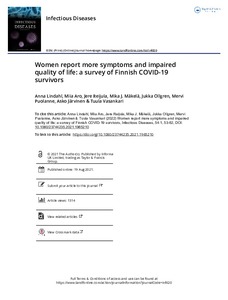Women report more symptoms and impaired quality of life: a survey of Finnish COVID-19 survivors
Lindahl Anna; Aro Miia; Reijula Jere; Mäkelä Mika J; Ollgren Jukka; Puolanne Mervi; Järvinen Asko; Vasankari Tuula
https://urn.fi/URN:NBN:fi-fe2022021619542
Tiivistelmä
Background
The long-term sequelae after COVID-19 are not yet fully known. Our aim was to evaluate subjective symptoms and quality of life in Finnish hospitalized COVID-19 patients at six months follow-up.
Methods
Hospitalised adult patients with laboratory-confirmed SARS-CoV-2 infection from March to June 2020 were recruited. We conducted a survey on demographics and comorbidities, ten specific symptoms, and a RAND-36 quality of life questionnaire six months after hospital discharge. We collected clinical data manually from medical records.
Results
101 patients (54 male) out of 246 invited completed the survey. Their median age was 60 years, and the mean hospital length of stay was 15 d. Most patients (90%) experienced symptoms, the most common of which were tiredness (88%), fatigue (79%), sleeping problems (76%), and dyspnoea (70%). In regard to gender, women showed a shorter time of hospitalization (p = .048) and lower peak flow of supplementary oxygen (p = .043). Women reported more frequently dyspnoea, fatigue, tiredness, sleeping problems, and mood problems (p = .008-.033), and a lower quality of life in seven of eight dimensions (p < .001-.015). Five explanatory variables for the reduced quality of life were identified in multivariate analysis: age, female sex, BMI, sleep apnoea, and duration of mechanical ventilation. Of the patients who worked full-time before COVID-19, 11% had not returned to work.
Conclusions
Most patients experienced symptoms six months after hospital discharge. Women reported more symptoms and a lower quality of life than men. These findings highlight the differences in recovery between men and women and call for active rehabilitation of COVID-19 patients.
Kokoelmat
- Rinnakkaistallenteet [27094]
